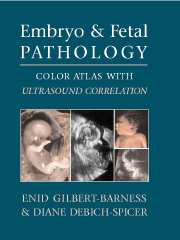Book contents
- Frontmatter
- Contents
- Foreword by John M. Opitz
- Preface
- Acknowledgments
- 1 The Human Embryo and Embryonic Growth Disorganization
- 2 Late Fetal Death, Stillbirth, and Neonatal Death
- 3 Fetal Autopsy
- 4 Ultrasound of Embryo and Fetus: General Principles
- 5 Abnormalities of Placenta
- 6 Chromosomal Abnormalities in the Embryo and Fetus
- 7 Terminology of Errors of Morphogenesis
- 8 Malformation Syndromes
- 9 Dysplasias
- 10 Disruptions and Amnion Rupture Sequence
- 11 Intrauterine Growth Retardation
- 12 Fetal Hydrops and Cystic Hygroma
- 13 Central Nervous System Defects
- 14 Craniofacial Defects
- 15 Skeletal Abnormalities
- 16 Cardiovascular System Defects
- 17 Respiratory System
- 18 Gastrointestinal Tract and Liver
- 19 Genito-Urinary System
- 20 Congenital Tumors
- 21 Fetal and Neonatal Skin Disorders
- 22 Intrauterine Infection
- 23 Multiple Gestations and Conjoined Twins
- 24 Metabolic Diseases
- Appendices
- Index
10 - Disruptions and Amnion Rupture Sequence
Published online by Cambridge University Press: 23 February 2010
- Frontmatter
- Contents
- Foreword by John M. Opitz
- Preface
- Acknowledgments
- 1 The Human Embryo and Embryonic Growth Disorganization
- 2 Late Fetal Death, Stillbirth, and Neonatal Death
- 3 Fetal Autopsy
- 4 Ultrasound of Embryo and Fetus: General Principles
- 5 Abnormalities of Placenta
- 6 Chromosomal Abnormalities in the Embryo and Fetus
- 7 Terminology of Errors of Morphogenesis
- 8 Malformation Syndromes
- 9 Dysplasias
- 10 Disruptions and Amnion Rupture Sequence
- 11 Intrauterine Growth Retardation
- 12 Fetal Hydrops and Cystic Hygroma
- 13 Central Nervous System Defects
- 14 Craniofacial Defects
- 15 Skeletal Abnormalities
- 16 Cardiovascular System Defects
- 17 Respiratory System
- 18 Gastrointestinal Tract and Liver
- 19 Genito-Urinary System
- 20 Congenital Tumors
- 21 Fetal and Neonatal Skin Disorders
- 22 Intrauterine Infection
- 23 Multiple Gestations and Conjoined Twins
- 24 Metabolic Diseases
- Appendices
- Index
Summary
Disruption is defined as a morphologic or structural anomaly of an organ, part of an organ, or a larger region of the body resulting from the extrinsic breakdown of, or interference with, an originally normal conceptus or developmental process. Disruptions tend to be sporadic occurrences (Figure 10.1 and Tables 10.1 to 10.6).
TYPES OF DISRUPTIONS AFFECTING MORPHOGENESIS OF THE DEVELOPING EMBRYO AND FETUS
■ Radiation
■ Hyperthermia
■ Infection
■ Teratogenic drugs
■ Metabolic
■ Vascular
■ Amnion disruption
TERATOGENIC DISRUPTIONS
Growth and development of the embryo can be adversely affected by a wide variety of environmental agents (teratogens). Teratogens include intrauterine infections, various chemical agents and medications, and maternal metabolic disorders.
The first two weeks of life that is, the time before organogenesis appears to be a relatively safe time for the embryo regarding teratogenic exposure. The next 45 days, however, are especially dangerous for it is during this period that most organs develop. After an organ has developed, unless there is disruption, the teratogen cannot cause a malformation. The same teratogen can cause different defects at different times of exposure.
Most teratogens produce a characteristic, clinically recognizable, pattern of abnormalities.
RADIATION EMBRYOPATHY
In utero radiation is associated with microcephaly, mental retardation, and stunted growth, especially in infants exposed between the 8th and 15th weeks of gestation, and there is an increased incidence of leukemia.
HYPERTHERMIC EMBRYOPATHY
Hyperthermia, a body temperature of at least 38.9°C, is an antimitotic teratogen when the fetus is exposed to a high temperature between the 4th and 16th week of gestation (Figure 10.2 and Table 10.7).
- Type
- Chapter
- Information
- Embryo and Fetal PathologyColor Atlas with Ultrasound Correlation, pp. 275 - 309Publisher: Cambridge University PressPrint publication year: 2004



